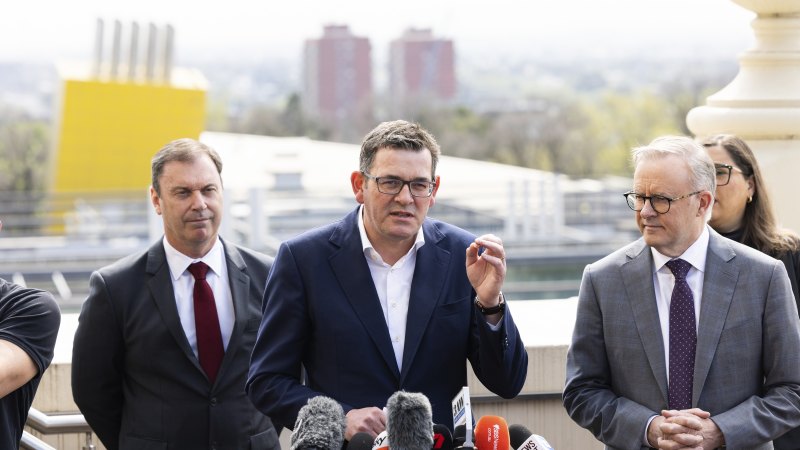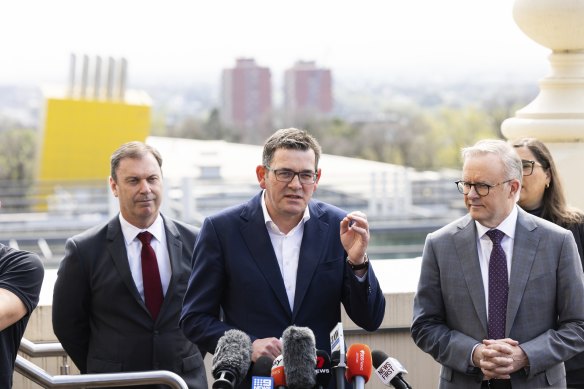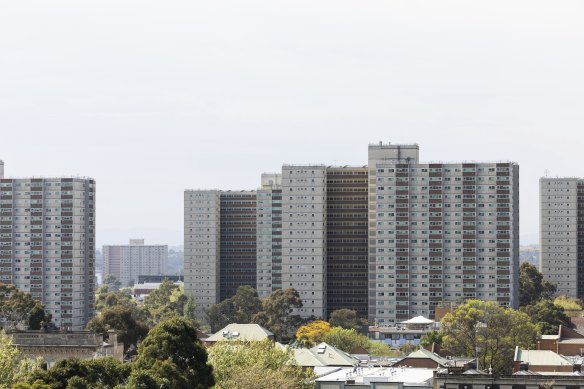Save articles for later
Add articles to your saved list and come back to them any time.
New apartments near key transport hubs will need to be bigger and have more natural light and developers will be enticed to build in priority precincts with faster approvals and taller height limits as part of the Victorian government’s plan to fix the state’s housing crisis.
The Andrews government will on Wednesday use new projections for Victoria’s population – growing an average 125,000 people a year over the next decade – to justify its major reforms of the housing and planning sectors.
Premier Daniel Andrews and Prime Minister Anthony Albanese in Carlton on TuesdayCredit: Paul Jeffers
Cabinet met late on Tuesday to finalise the first stage of its housing statement, which will seek to boost supply and help the government meet demand for one million extra homes in developed areas by 2050.
The Age has spoken to a dozen sources familiar with the plans, including government MPs and stakeholders briefed before the plan’s release.
The policy, which has been months in the making, will include incentives for large developers to build social and affordable homes as part of major projects.
Industry and government sources involved in consultations, who were not authorised to speak on the record about the government’s plans, said the housing reforms would be accompanied by design standards that would require Melbourne’s new higher-density areas to be built with more room, better energy use and more natural light.
They said incentives included taller height limits, and faster planning processes to build developments in priority precincts or build developments valued over a certain price threshold – believed to be in the tens of millions.
In 2022, a parliamentary inquiry called on Victoria to update its apartment design standards and the government was yet to formally respond to its recommendations. Multiple Labor MPs said this response would come in the form of the housing statement.
Key recommendations from that report included updating apartment standards to include a minimum size for new builds, a clear definition of “adequate daylight” and requirements for environmental sustainability.
Victoria needs more housing close to essential services.Credit: Paul Jeffers
Speaking on Tuesday as he announced the redevelopment of Carlton’s housing towers, Premier Daniel Andrews said Melbourne’s growth couldn’t continue to go only to the outer fringes and more density was needed.
“We have to go up and out,” he said.
“But, I hasten to add, high quality from a public realm point of view. Natural light, access to services, all of those things – design can’t be compromised.
“You can make good decisions and you can make them a good deal faster than we have been.”
The government has not revealed which areas will be declared as priority precincts to be transformed.
Andrews has previously said the state government would take some planning powers away from local councils as part of its reforms.
Industry figures said under the reforms this could include the use of new state-appointed metropolitan planning boards, which could take over planning for developments above a certain value or within “priority precincts” close to transport hubs.
The property industry has also used discussions to push for “density bonuses”, which allow developers to build above height or size limits if they agree to build a set percentage of social or affordable homes. Stakeholders were expecting an overhaul of contributions to infrastructure for growth areas and green open space.
The Andrews government is also planning to introduce a new levy on short-term accommodation, excluding hotels, covered by platforms such as Airbnb.
Planning Minister Sonya Kilkenny will on Wednesday point to the government’s official population projections as the state reveals its housing statement.
It expects the state to add 3.5 million people by 2051, taking Melbourne’s population to 8 million and the total number of people in Victoria to 10.3 million. That will require an additional 1.6 million dwellings across the state.
Mitchell Shire, in Melbourne’s north, was projected to expand more than any other local government area, as a proportion of its size, adding 6 per cent more people a year between 2021 and 2036.
The biggest boom in Melbourne until 2051 was expected to be in the inner local government areas of Melbourne, Port Phillip and Yarra, followed by the western and northern regions that were viewed as having the capacity to accommodate more people.
Victoria’s population grew faster than any other state or territory in Australian history in 2022-23, exploding by an estimated 175,000 people or 2.6 per cent.
Growth is expected to stabilise at an average 125,000 people a year, or 1.5 per cent, over the next decade.
“Victoria is the fastest growing state in Australia – and we need a planning system that can deliver good planning decisions faster and more effectively,” Kilkenny said.
“With a growing population, we know we have more to do to meet the growing needs of our state and ensure more Victorians can live where they want to live and closer to jobs, services and transport.”
Linda Allison, the Victorian chief executive of the Urban Development Institute of Australia, said the government should not solely focus on established inner suburbs to increase housing supply.
She said the institute was not in favour of a blanket rule requiring all new developments to include social housing, which she said should be determined on a case-by-case basis where it was feasible.
Opposition housing spokeswoman Jess Wilson said it would be deeply concerning if the government moved to silence local residents over decisions affecting their communities.
Get the day’s breaking news, entertainment ideas and a long read to enjoy. Sign up to receive our Evening Edition newsletter here.
Most Viewed in National
From our partners
Source: Read Full Article







